The Gift of Poetry
My almost-five-year-old granddaughter distributed our gifts on Christmas morning. “This one’s really heavy, Grandma,” she announced as she placed a large colored bag beside me on the couch. “I think you should open it next.”
When it was my turn to open a present, Bean scrambled onto the sofa beside me, kicking her feet excitedly. The bag was filled with tissue paper-wrapped items. I slowly removed the first one, unwrapping it carefully.
“A tin of tea!” I exclaimed. Bean wrinkled her nose.
“That wasn’t it. It’s not heavy enough.”
I began unwrapping the second item. Slowly, stretching out the suspense. I removed the first sheet of tissue, folded it and began unwrapping the second. But before I could display the lovely Wedgwood ornament for all to see, Bean reached into the bag, put both hands around the bottom of the large fat book that remained, and pulled it out triumphantly.
“It’s a book, Grandma! Read it to me!”
And so, together, bringing the family unwrapping party to a temporary halt, we opened our new treasure, Great Poems for Grand Children.
Exploring Our New Book
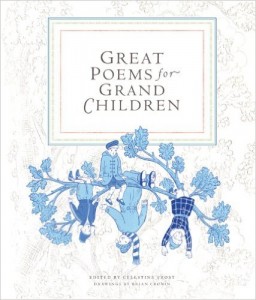 Bean is a fortunate child; she has several grandparents, two parents, three preschool teachers, and several special friends of the family, all happy to read to her whenever she asks. But this was a new experience for her, as it was for me: opening a brand new book and exploring it together.
Bean is a fortunate child; she has several grandparents, two parents, three preschool teachers, and several special friends of the family, all happy to read to her whenever she asks. But this was a new experience for her, as it was for me: opening a brand new book and exploring it together.
Normally when I encounter a book for the first time I scan the front and back covers, the front and back flaps, and then I read the preface and introduction. But that’s not how an almost-five-year-old does it.
She pulled the book into her lap, grabbed a chunk of pages and flipped them through her fingers, stopping on page 43, where two curved rows of words appeared to be falling off the page.
“Read this one, Grandma! What does it say?” I looked at the poem, which was titled A Weak Poem (To Be Read Lying Down), and promptly lay down on the sofa, my head nestled behind Bean’s cute little back side. I held the book above my head and read: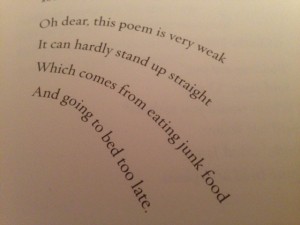
Giggles ensued. Thank you to author Roger McGough for starting our reading with such an amusing image.
I sat up and moved on to the Whole Duty of Children by Robert Louis Stevenson, which was right above A Weak Poem:
More giggles. Clearly Bean was not brought up in MY family home, where those tenets were actually the rules I was expected to adhere to. So I told her that those words were not meant to be funny. We went over each line and talked about what they meant, and then she smiled. She did, in fact, know what rules were, and she had understood the poem. However, I didn’t get very long to enjoy the moment.
“Read some more, Grandma.”
Read Some More, Grandma
And so it went, that day and the next and the next. We have now read twenty or thirty poems, and our new book has become a fixture on my coffee table.
Reading poetry to children, whether serious, silly, metered or random, can serve as a bridge between the generations. This particular collection, compiled by The American Association of Retired Persons (AARP) especially for grandparents to read to their grandchildren, is filled with rhymes from my childhood and yours that bring memories to life that deserve to be shared. But more remarkably, they sit beside contemporary poems that provide a glimpse of the world as today’s youngsters see it, and “inspire reflection on the new lives you are helping to shape” (back flap).
For example, The Adventures of Isabel (1936) by Ogden Nash faces The Drum (2013) by Nikki Giovanni. And Barbara Huff’s 2007 poem, Afternoon with Grandmother faces The Cupboard, written by Walter De La Mare (1973-1956). There are poems by Mark Twain and Emily Dickinson, and poems by Maya Angelou and Shel Silverstein.
Once Christmas morning was over, and I had time to explore our new book in my own fashion I confirmed that it is a real treasure. Edited by Celestine Frost and illustrated delightfully by Brian Cronin, the poems are clustered by type and somewhat by age of children who will enjoy them. Starting with Nursery Rhymes, Tongue Twisters, and Nonsense Verses, follow sections labeled My Home, Bedtime, Animal Friends, Seasons, Fairies, Witches, Goblins & Company, and Wise Words. You can pick up the book and turn randomly to a page that catches your eye, as Bean did on our first day, or methodically work your way through a section.
But it isn’t a book just for grandchildren. Many of the poems selected for this collection touch the souls of grownups (for example, Annabel Lee, by Edgar Allan Poe and How Do I Love Thee? by Elizabeth Barrett Browning). I find reading a few poems in the afternoon a relaxing and enjoyable activity. Sometimes I mark one or more to share the next time Bean comes over; others I simply enjoy for the images they invoke, and the simple joy of reading the words. Keeping the book within reach means that I reach for it now and then, and I am enjoying revisiting poems that are old friends as well as being introduced to new verses.
Published in 2010 by the AARP, Great Poems for Grand Children can now be obtained as a remainder from many sources, including Amazon.com. I highly encourage you to purchase it and keep in an easy-to-get-to place in your front room. How about on your coffee table?
If you enjoyed this essay, please share it on social media:
Share this post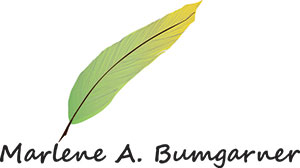
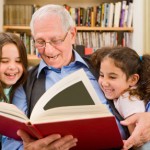

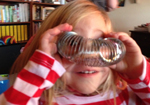

Thanks for your summary Jazmyne.
For her blog post on December 28 2015, Ms. Bumgarner talks about how poetry connects herself with her grandchildren. According to Bumgarner (2015), reading poetry to children can serve as a bridge between generation. In Bumgarner’s (2015) blog, she notices that tenets she grew up with did not make sense to her modern granddaughter who just laughed, until she told her what they meant. This is an example of where the extended family’s influence helps mold a child. The extended family has always included “grandparents, cousins, aunts, and others” (Lightfoot, Cole & Cole, 2013, pg. 346). Although not as emphasized as nuclear families, they are still important to have in order for a child have extra support when their parents can’t be there. The fact her granddaughter wants to read with her is really showing how much of a bond already she has with her grandmother. The time she spends with her granddaughter not only teaches her the joys of reading, but also gets them to share precious moments with each other.
Reference List
Bumgarner, M. A. (2015, December 28). Building Connections: Reading Poems to
Grandchildren. [Web log post] Retrieved July 28, 2016, from
http://www.marlenebumgarner.com/
Lightfoot, C., Cole, M., & Cole, S. R. (2013). The development of children. New York: Worth.